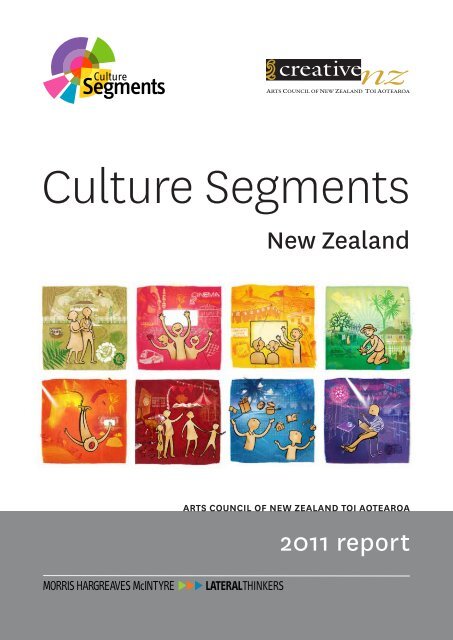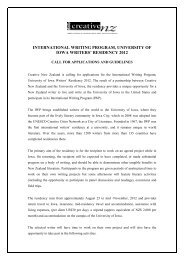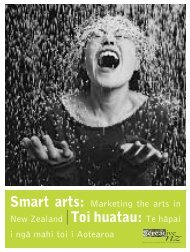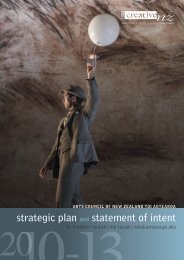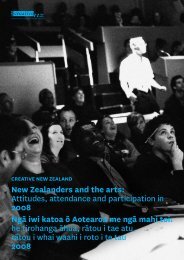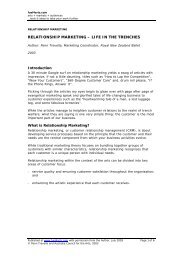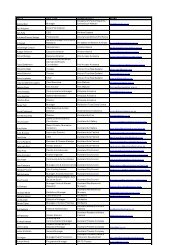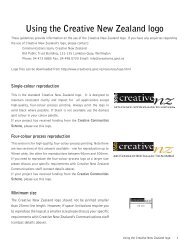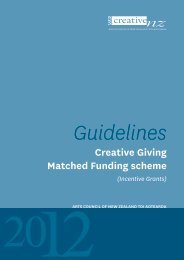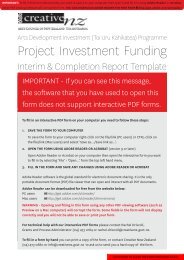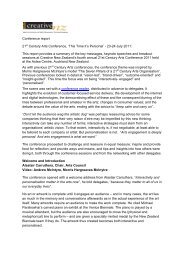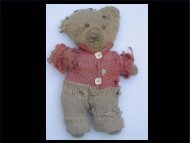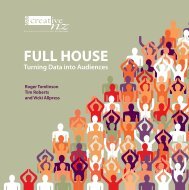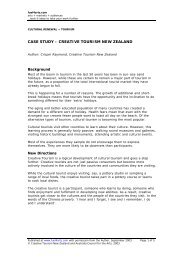Culture Segments - Creative New Zealand
Culture Segments - Creative New Zealand
Culture Segments - Creative New Zealand
Create successful ePaper yourself
Turn your PDF publications into a flip-book with our unique Google optimized e-Paper software.
<strong>Culture</strong><br />
<strong>Segments</strong><br />
<strong>Culture</strong> <strong>Segments</strong><br />
<strong>New</strong> <strong>Zealand</strong><br />
Arts Council of <strong>New</strong> <strong>Zealand</strong> Toi AoteAroa<br />
2011 report<br />
1
<strong>Culture</strong> <strong>Segments</strong> <strong>New</strong> <strong>Zealand</strong> 2011 report prepared for<br />
<strong>Creative</strong> <strong>New</strong> <strong>Zealand</strong> by Morris Hargreaves McIntyre.<br />
June 2012<br />
Morris Hargreaves McIntyre is an international strategic<br />
research consultancy working within the culture, heritage,<br />
leisure, media and charities sectors. Our specialism is in<br />
helping organisations develop enhanced consumer focus.<br />
Our company was born out of a desire to help cultural<br />
organisations become more creative in the way in which they<br />
are managed, more audience focused, more engaging, able<br />
to deliver greater impact and, as a result, more successful<br />
and sustainable. This founding ethos remains at the core of<br />
all our activity today.<br />
Research is a means to an end in our world. We believe that<br />
knowledge and insight are the key to sustainable change<br />
and a successful sector. However, what we find is that most<br />
research is tactical not strategic, leaving many fundamental<br />
questions on the market for the arts unanswered.<br />
Clients keep asking us the same questions – how can we<br />
better understand and reach our potential market? To<br />
address these directly, we have developed two new sector<br />
specific products. Audience Atlas and <strong>Culture</strong> <strong>Segments</strong>.<br />
If you would like to find out morE<br />
Please contact Jooles Clements<br />
jooles.clements@lateralthinkers.com<br />
Morris Hargreaves McIntyre<br />
137 Richmond Rd<br />
Grey Lynn<br />
Auckland 1021<br />
T: +64 (0)9 5517776<br />
www.lateralthinkers.com<br />
<strong>Creative</strong> <strong>New</strong> <strong>Zealand</strong> Contact Details<br />
CENTRAL REGION<br />
Wellington Office<br />
Level 2<br />
Old Public Trust Building<br />
131-135 Lambton Quay<br />
Wellington 6011<br />
PO Box 3806<br />
Wellington 6140<br />
T: (04) 473 0880<br />
F: (04) 471 2865<br />
E: info@creativenz.govt.nz<br />
NORTHERN REGION<br />
Auckland Office<br />
Third Floor<br />
Southern Cross Building<br />
59-67 High St<br />
Auckland 1010<br />
PO Box 1425, Shortland Street<br />
Auckland 1140<br />
T: (09) 373 3066<br />
F: (09) 377 6795<br />
E: northern@creativenz.govt.nz<br />
SOUTHERN REGION<br />
Christchurch Office<br />
Currently there is no physical address<br />
PO Box 3806<br />
Wellington 6140<br />
T: (03) 366 2072<br />
E: southern@creativenz.govt.nz<br />
2
Audience Atlas<br />
<strong>Culture</strong> <strong>Segments</strong><br />
Audience Atlas <strong>New</strong> <strong>Zealand</strong> Report 2011 is the most<br />
detailed survey of cultural audiences ever undertaken in<br />
<strong>New</strong> <strong>Zealand</strong>.<br />
It is robust and representative. Audience Atlas <strong>New</strong> <strong>Zealand</strong><br />
Report 2011 samples 3,900 adult respondents (aged over 15)<br />
who are in the market for art, culture and heritage activities<br />
and events. They are drawn from across the <strong>New</strong> <strong>Zealand</strong><br />
regions and carefully weighted to be representative of the<br />
whole market.<br />
It’s rich and relevant. Audience Atlas <strong>New</strong> <strong>Zealand</strong> goes<br />
beyond the usual profiling. It measures lapsed and<br />
potential, not just recent engagement. It maps the market’s<br />
motivations, not just its behaviour. Audience Atlas covers<br />
60 artforms and leisure activities and almost 650 individual<br />
arts and heritage venues across <strong>New</strong> <strong>Zealand</strong>.<br />
It’s powerful and practical. Audience Atlas <strong>New</strong> <strong>Zealand</strong><br />
defines your market. Then it cross analyses your lapsed,<br />
current and potential future market to provide detailed<br />
insight into your audiences. It supports realistic target<br />
setting, identification of potential markets and partner<br />
organisations. It provides powerful data for funders.<br />
It puts your finger on the market’s pulse. Audience Atlas<br />
<strong>New</strong> <strong>Zealand</strong> is right up to date. It is regularly updated to<br />
reflect and map trends over time.<br />
If you want to know the size and characteristics of your<br />
current and potential market – you need Audience Atlas.<br />
<strong>Culture</strong> <strong>Segments</strong> is a new, international, sector-specific<br />
segmentation system for arts, culture and heritage<br />
organisations. The system is powered by data from Audience<br />
Atlas <strong>New</strong> <strong>Zealand</strong>, and draws upon a decade’s leading-edge<br />
practice helping organisations to truly understand and meet<br />
the needs of audiences for arts, culture and heritage.<br />
The principle objective of <strong>Culture</strong> <strong>Segments</strong> is to provide<br />
the sector with a shared, international language for<br />
understanding the audience, with a view to targeting them<br />
more accurately, engaging them more deeply and building<br />
lasting relationships.<br />
<strong>Culture</strong> <strong>Segments</strong> is designed to be more subtle, granular<br />
and sophisticated than existing segmentation systems.<br />
This is because it is based on people’s cultural values and<br />
motivations. These cultural values define the person and<br />
frame their attitudes, lifestyle choices and behaviour.<br />
The segments are distinguished from one another by deeplyheld<br />
beliefs about the role that art and culture play in their<br />
lives, enabling you to get to the heart of what motivates<br />
them and develop strategies to engage them more deeply.<br />
<strong>Culture</strong> <strong>Segments</strong> has highly practical applications. The<br />
system is Consumer & Media View ready, which means you<br />
can use it with your media planning agency to increase<br />
effectiveness. It uses a small set of Golden Questions, which<br />
can easily be included in audience surveys and databases to<br />
evaluate the success of campaigns and better understand<br />
your existing audiences. The system can also be used to<br />
recruit focus group respondents and build online panels<br />
to explore your brand, test your marketing campaigns and<br />
inform product development.<br />
If you want to reach new audiences and meet their needs<br />
more effectively – you need <strong>Culture</strong> <strong>Segments</strong>.<br />
<strong>Culture</strong><br />
<strong>Segments</strong><br />
3
The market<br />
95%<br />
of <strong>New</strong> <strong>Zealand</strong>’s (15+) population are in the market for<br />
arts, culture and heritage (3,347,000 individuals)<br />
Tickets<br />
Food & drink<br />
Souvenirs<br />
Between them they spent a total of<br />
$2.31 billion<br />
on arts/culture/heritage in the last 12 months<br />
55%<br />
state their spending on arts/culture/heritage will stay<br />
the same or increase in the next 12 months<br />
4
The segments<br />
We have identified eight segments within the market for arts, culture<br />
and heritage:<br />
Enrichment<br />
Entertainment<br />
Expression<br />
Perspective<br />
mature<br />
traditional<br />
heritage<br />
nostalgia<br />
consumers<br />
popularist<br />
leisure<br />
mainstream<br />
receptive<br />
confident<br />
community<br />
expressive<br />
settled<br />
self-sufficient<br />
focused<br />
contented<br />
Stimulation<br />
Affirmation<br />
Release<br />
Essence<br />
active<br />
experimental<br />
discovery<br />
contemporary<br />
self-identity<br />
aspirational<br />
quality time<br />
improvement<br />
busy<br />
ambitious<br />
prioritising<br />
wistful<br />
discerning<br />
spontaneous<br />
independent<br />
sophisticated<br />
5
Each segment has different levels of spending and consumption<br />
Each segment has different levels of spending and consumption<br />
<strong>Culture</strong><br />
<strong>Segments</strong><br />
% who have spent on culture in the past month Average annual frequency of arts attendance<br />
% who have spent on culture in the past month<br />
Average annual frequency<br />
of arts attendance<br />
Enrichment:<br />
29<br />
%<br />
10<br />
Entertainment:<br />
13<br />
%<br />
8<br />
Expression:<br />
52<br />
%<br />
23<br />
Perspective:<br />
Stimulation:<br />
Affirmation:<br />
Release:<br />
Essence:<br />
27%<br />
0 10 20 30 40 50 60<br />
45 %<br />
0 10 20 30 40 50 60<br />
46 %<br />
0 10 20 30 40 50 60<br />
28%<br />
0 10 20 30 40 50 60<br />
47%<br />
0 10 20 30 40 50 60<br />
7<br />
17<br />
16<br />
13<br />
20<br />
6
ENRICHMENT<br />
Mature<br />
Traditional<br />
Heritage<br />
Nostalgia<br />
320,600 adults<br />
10%<br />
7
ENRICHMENT<br />
Who are they?<br />
The Enrichment segment are characterised by older adults with<br />
time to spare who like spending their leisure time close to the<br />
home. They have established tastes and enjoy culture that links<br />
into their interests in nature, heritage and more traditional<br />
artforms.<br />
Age profile<br />
Children at home<br />
Children<br />
20%<br />
Attitudes and life priorities<br />
NATURE, GARDENING, THE OUTDOORS<br />
TRADITIONAL ARTFORMS<br />
HOME LIFE<br />
THE PAST<br />
FAITH<br />
ARTS AND CRAFTS<br />
27%<br />
Highest education<br />
level reached<br />
Vocational<br />
32%<br />
16% Degree<br />
Up to school 45%<br />
23%<br />
16 - 34<br />
48%<br />
35 - 64<br />
36%<br />
65+<br />
What needs are they looking to fulfil?<br />
The Enrichment segment tends to be in the later stages of life and<br />
are unlikely to have children at home. They are a risk averse<br />
segment with established tastes. They know what they like and<br />
their visits to cultural organisations are very much driven by their<br />
own interests and not those of others, nor what is considered to<br />
be new or fashionable.<br />
The arts and culture fits with their interests in heritage,<br />
gardening and nature. It is these interests, along with the desire<br />
to experience nostalgia, awe and wonder, which motivates<br />
them to engage with culture. Rather than the opportunity to<br />
seek out new experiences, the arts provides this segment with a<br />
form of warm escapism, offering a means to reach even greater<br />
fulfilment within their lives.<br />
What do they do?<br />
Artform interest<br />
index:<br />
Annual artform<br />
frequency index:<br />
Annual artform<br />
frequency:<br />
Likes and dislikes<br />
-10<br />
-39<br />
10<br />
The arts sit in the middle of this segment’s leisure priorities, below<br />
their garden, home life and the outdoors. Consumption is<br />
moderately high and tends to focus on traditional artforms and<br />
heritage days out, such as historic properties, parks and formal<br />
gardens.<br />
Likes<br />
Heritage<br />
Historic houses<br />
Parks<br />
Gardens<br />
Opera<br />
Theatre<br />
Classical music<br />
Birdwatching<br />
Music events<br />
Festivals<br />
Popular culture<br />
Experimental<br />
Cutting edge<br />
Trends<br />
Contemporary<br />
Dislikes<br />
8
ENRICHMENT<br />
What is their value?<br />
Expenditure<br />
Support<br />
Donated to arts, cultural or heritage organisations in last 3 years<br />
52%<br />
29%<br />
Maintain or increase<br />
level of expenditure<br />
Spent on culture<br />
past month<br />
No<br />
52%<br />
Yes<br />
48%<br />
Spend indices<br />
Tickets<br />
Food &<br />
drink<br />
12%<br />
23%<br />
Souvenirs<br />
Member of arts /<br />
cultural organisation<br />
Ever volunteered in<br />
arts / culture sector<br />
Despite slightly above average levels of attendance, with a high<br />
incidence of retirement and relatively low income levels, this<br />
segment tends to restrict secondary spend when visiting cultural<br />
venues. Value for money is very important to this segment; they<br />
are more likely to take a packed lunch than spend unnecessarily<br />
on on-site catering.<br />
Whilst secondary spend is generally low, this segment likes to<br />
invest in the core experience, spending more on tickets than<br />
other segments. They have established tastes and will remain<br />
loyal to a small number of organisations that can cater well for<br />
their needs – for this reason they have development potential for<br />
the right venues.<br />
How to reach this segment<br />
Focus on<br />
nostalgia<br />
Highlight the<br />
traditional and<br />
established<br />
Key marketing proposition<br />
Provide<br />
good value<br />
for money<br />
‘Focus on their established tastes and<br />
desire to experience nosalgia, awe<br />
and wonder’<br />
The key to engaging the Enrichment segment is to focus on their<br />
interests in heritage, gardening, nature, nostalgia, beauty and the<br />
past. They are risk averse and mature individuals who are not<br />
looking to broaden their horizons or to be taken outside their<br />
cultural comfort zone. They have a core set of venues,<br />
destinations and organisations that they will support and rarely<br />
explore further. Developing this segment will then require<br />
encouraging them to try something new that fits with their<br />
established tastes and appeals to their hobbyist interests.<br />
They have moderate media consumption, with above average<br />
readership of regional and local free press. They regularly watch<br />
TV1, TV2, TV3, C4 or Prime and listen to Radio <strong>New</strong> <strong>Zealand</strong> and<br />
Radio <strong>New</strong> <strong>Zealand</strong> Concert. They show below average Internet<br />
use. As they do not actively seek out information, the way to<br />
reach this segment is via their specific hobbies and social groups;<br />
and through their prefered, established media brands.<br />
9
ENTERTAINMENT<br />
Consumers<br />
Popularist<br />
Leisure<br />
Mainstream<br />
337,400 adults<br />
10%<br />
10
ENTERTAINMENT<br />
Who are they?<br />
Children at home<br />
The Entertainment segment tends to be conventional, younger<br />
adults for whom the arts are on the periphery of their lives. Their<br />
occasional forays into culture are usually for spectacular,<br />
entertaining or must-see events, and compete against a wide<br />
range of other leisure interests.<br />
Attitudes and life priorities<br />
HOME AND PUB<br />
TV, CELEBRITY, SPORTS<br />
THRILL<br />
ESCAPISM<br />
PRIORITIES ARE VERY CLOSE TO HOME<br />
Age profile<br />
50%<br />
41%<br />
16 - 34 35 - 64<br />
35%<br />
65+<br />
Children<br />
39%<br />
Highest education<br />
level reached<br />
Vocational<br />
34%<br />
Up to school<br />
9%<br />
31% Degree<br />
35%<br />
What needs are they looking to fulfil?<br />
This segment looks for escapism and thrill in leisure activities.<br />
Leisure time is for fun, not for learning or applying oneself<br />
intellectually – this is something they are looking to escape from<br />
through their leisure pursuits. They are largely socially motivated<br />
to attend, looking to pass time in an enjoyable and fun way with<br />
friends and family. For the most part they cannot envisage that<br />
they will meet these needs through engaging with arts and<br />
culture.<br />
The Entertainment segment prefers to stick to the tried and<br />
tested when it comes to lesiure pursuits and is not looking to be<br />
challenged or to take risks in discovering something new. They<br />
worry about what other people think about them and therefore<br />
do not want to be seen to go against the grain or to try things<br />
that do not have established, popular currency.<br />
What do they do?<br />
Artform interest<br />
index:<br />
Annual artform<br />
frequency index:<br />
Annual artform<br />
frequency:<br />
Likes and dislikes<br />
-37<br />
-49<br />
8<br />
The Entertainment segment has a very sporadic relationship with<br />
the arts and culture, attending popular, blockbuster events that<br />
have received widespread positive reviews and that they know<br />
they are guaranteed to enjoy. They enjoy popular cultural events<br />
and activities that are exciting and spectacular such as carnival,<br />
panto, popular music and blockbuster films.<br />
Likes<br />
Blockbuster<br />
Must-see<br />
spectacle<br />
Musicals<br />
Carnival<br />
Cinema<br />
Pop music<br />
Panto<br />
Classical<br />
Specialist<br />
Intellectual<br />
Discovery<br />
Museum<br />
Galleries<br />
Dance<br />
Exhibitions<br />
Dislikes<br />
11
ENTERTAINMENT<br />
What is their value?<br />
Expenditure<br />
Support<br />
Donated to arts, cultural or heritage organisations in last 3 years<br />
41%<br />
Maintain or increase<br />
level of expenditure<br />
13%<br />
Spent on culture<br />
past month<br />
Yes<br />
25%<br />
Spend indices<br />
No<br />
75%<br />
Tickets<br />
Food &<br />
drink<br />
Souvenirs<br />
3%<br />
Member of arts /<br />
cultural organisation<br />
9%<br />
Ever volunteered in<br />
arts / culture sector<br />
The arts and culture are only one of many leisure choices for the<br />
Entertainment segment. They prefer to enjoy theme parks,<br />
sports, the beach, package holidays and a night in the pub. When<br />
they do engage in the arts they tend to be consumers rather than<br />
creators or participators, and stick to mainstream cultural<br />
activities. They will pay a premium for something that they are<br />
keen to see, but it will need to be spectacular and must-see<br />
when it comes to culture.<br />
They do not believe that the arts contribute to people’s lives or<br />
society at large, and therefore tend not to support public<br />
subsidy of the arts. They spend little time worrying about issues<br />
such as faith, the environment or consumerism, but are<br />
concerned with issues closer to home, such as the cost of living<br />
and local issues. They have limited development potential as<br />
either supporters or volunteers.<br />
How to reach this segment<br />
Link into<br />
mainstream<br />
through TV,<br />
sports and<br />
celebrity<br />
Emphasis on<br />
one off,<br />
must-see<br />
events and<br />
shows<br />
Key marketing proposition<br />
Promote<br />
escapism and<br />
excitement<br />
‘Highlight the thrilling and must-see<br />
elements, position as a blockbuster event’<br />
The Entertainment segment is only willing to spend on leisure and<br />
recreation if they believe it will meet all of their needs. While they<br />
may not see a value in the arts and culture per se, the right type of<br />
event has the potential to provide exactly what they want –<br />
primarily escapism and thrill.<br />
Advertising via mainstream media heavily influences them. Their<br />
children also influence their behaviour so pester power would<br />
work on this segment. As they are not looking for anything overtly<br />
cultural; ‘culture’ needs to be downplayed in the marketing, with<br />
messaging emphasising the ‘must-see’, ‘not to be missed’, ‘thrill’<br />
and ‘blockbuster’ elements of the offer.<br />
They have below average readership of newspapers instead<br />
preferring to use the Internet for their news consumption. They<br />
tend to watch Sky TV or other digital TV channels and are frequent<br />
consumers of commerical radio stations and sports magazines.<br />
12
EXPRESSION<br />
Receptive<br />
Confident<br />
Community<br />
Expressive<br />
861,900 adults<br />
26%<br />
13
EXPRESSION<br />
Who are they?<br />
Children at home<br />
The Expression segment is in-tune with their creative and spiritual<br />
side. They are confident, fun-loving, self-aware people who<br />
accommodate a wide range of interests, from culture and learning,<br />
to community and nature.<br />
Age profile<br />
Children<br />
32%<br />
Attitudes and life priorities<br />
LIVING LIFE TO THE FULL<br />
COMMUNITY AND FAMILY<br />
ARTS AND CULTURE<br />
FAITH AND SPIRITUALITY<br />
NATURE<br />
35%<br />
16 - 34<br />
45%<br />
35 - 64<br />
21%<br />
65+<br />
Highest education<br />
level reached<br />
Vocation<br />
33%<br />
Up to school<br />
33%<br />
Degree<br />
34%<br />
What needs are they looking to fulfil?<br />
This segment actively pursues life. Their free time is highly valued<br />
and they try to cram in as much as possible to make the most of it.<br />
Open and receptive to new ideas, they pursue challenge,<br />
entertainment and intellectual stimulation through their cultural<br />
engagement.<br />
They enjoy being part of a crowd and seek communal<br />
experiences that broaden horizons. Arts and culture is a key<br />
element of their lifestyle, it is a means of self-expression and<br />
connecting with other like-minded individuals who share their<br />
deeply-held values about the world around them.<br />
What do they do?<br />
Artform interest<br />
index:<br />
Annual artform<br />
frequency index:<br />
Annual artform<br />
frequency:<br />
Likes and dislikes<br />
+3<br />
+43<br />
23<br />
The Expression segment is highly culturally active and open to a<br />
broad spectrum of artforms. They enjoy the arts and culture<br />
frequently in an active rather than passive manner, seeking<br />
inspiration and opportunities for self-expression through their<br />
engagement. They like hands-on involvement and active debate.<br />
Likes<br />
Natural heritage<br />
Films<br />
Festivals and<br />
exhibitions<br />
Having a go<br />
Exclusivity<br />
Dislikes<br />
14
EXPRESSION<br />
What is their value?<br />
Expenditure<br />
Support<br />
Donated to arts, cultural or heritage organisations in last 3 years<br />
64%<br />
52%<br />
Spend indices<br />
Maintain or increase<br />
level of expenditure<br />
Spent on culture<br />
past month<br />
No<br />
39%<br />
Yes<br />
61%<br />
Tickets<br />
Food &<br />
drink<br />
22%<br />
36%<br />
Souvenirs<br />
Member library/arts/<br />
cultural organisation<br />
Ever volunteered in<br />
arts/culture sector<br />
Their activity levels result in above-average expenditure in the arts.<br />
However, value for money and emotional engagement is important<br />
to this segment and they may avoid financial risks unless they are<br />
sure of the benefits to them. They tend to be loyal supporters of<br />
arts brands who mirror their own values and lifestyle choices.<br />
The Expression segment strongly believes in the benefits of the arts<br />
and is supportive of public subsidy. They have above-average<br />
membership of arts, heritage and cultural organisations and their<br />
strong sense of community means that they are willing to volunteer<br />
their time for the greater good. They are ripe for campaigning<br />
relationships.<br />
How to reach this segment<br />
Debate and<br />
discuss<br />
Build networks<br />
that appeal to<br />
their community<br />
spirit<br />
Highlight the<br />
opportunities<br />
for participation<br />
Whilst obscure and little-known names are appealing to this<br />
segment, so too are more mainstream artforms, as they don’t hold<br />
disdain for popular culture. They believe that expressing an opinion<br />
is more important than following carefully developed taste; culture<br />
is for sharing and discussing with others.<br />
Key marketing proposition<br />
‘Tap into their desire to be part<br />
of something bigger’<br />
Although they like adventure, innovation and discovery, the<br />
Expression segment also like to know what they’re letting<br />
themselves in for. Their receptiveness to the views of others and<br />
happiness to lead from within, rather than be at the forefront of<br />
cutting-edge arts and culture, means they are open to reviews and<br />
recommendations. Rather than reject marketing communications<br />
they see them as a useful tool for being more discerning.<br />
Keeping up to date with current affairs both home and abroad is<br />
important. They are avid consumers of print media – in particular<br />
the <strong>New</strong> <strong>Zealand</strong> Herald, Dominion Post, The Press and a variety of<br />
other major newspapers and magazines, as well as regional press.<br />
They also listen to major radio stations such as The Breeze, Classic<br />
Hits and Coast FM.<br />
15
PERSPECTIVE<br />
Settled<br />
Self-sufficient<br />
Focused<br />
Contented<br />
244,900 adults<br />
7%<br />
16
PERSPECTIVE<br />
Who are they?<br />
Age profile<br />
Children at home<br />
The Perspective segment is settled, fulfilled and home-orientated.<br />
The arts and culture are low among their priorities, however their<br />
underlying spontaneous nature, need to make their own<br />
discoveries and desire to learn provides a focus for engaging with<br />
arts and culture.<br />
57%<br />
Children<br />
22%<br />
Attitudes and life priorities<br />
OPTIMISTIC<br />
THEIR OWN NEEDS ARE IMPORTANT<br />
INNER DIRECTED<br />
READING<br />
LEARNING<br />
THE OUTDOORS<br />
29%<br />
16 - 34<br />
35 - 64<br />
14%<br />
65+<br />
Highest education<br />
level reached<br />
Up to<br />
school<br />
40%<br />
Vocational<br />
31%<br />
Degree<br />
29%<br />
What needs are they looking to fulfil?<br />
The Perspective segment has an optimistic outlook, they are<br />
inner-directed and prioritise their own needs above others. Whilst<br />
this means they are highly contented, their horizons have become<br />
somewhat narrowed. They tend to gravitate to a limited ‘days out’<br />
focus in their leisure time, based around a small number of<br />
interests that have become habitual over time.<br />
The Perspective segment doesn’t see the arts as essential; culture<br />
for them is not part of their identity. Nevertheless they do see<br />
some forms of culture as providing the opportunity to pursue an<br />
interest or broaden their horizons, and it is this area which offers<br />
the greatest potential to increase the scope of their cultural<br />
consumption – by offering them a new pespective on life and the<br />
things that they are already interested in.<br />
What do they do?<br />
Artform interest<br />
index:<br />
Annual artform<br />
frequency index:<br />
Annual artform<br />
frequency:<br />
Likes and dislikes<br />
-24<br />
-54<br />
7<br />
The range of artforms that the Perspective segment engage with,<br />
or show an interest in engaging with, is relatively small and largely<br />
limited to the outdoors and nature activities. Their tastes tend to<br />
lean towards the traditional over the contemporary, topics such as<br />
literature, history and the natural world have the potential to spark<br />
their interest. They show an interest in libraries, museums and<br />
other cultural venues that focus on learning, as a means of further<br />
developing their specific interests and broadening their horizons.<br />
Likes<br />
Formal gardens<br />
Large parks<br />
Scenic<br />
Birdwatching<br />
Literature events<br />
Museums<br />
Contemporary<br />
High-brow<br />
Music festivals<br />
and events<br />
Theme parks<br />
Dislikes<br />
17
PERSPECTIVE<br />
What is their value?<br />
Expenditure<br />
Support<br />
Donated to arts, cultural or heritage organisations in last 3 years<br />
51%<br />
27%<br />
Maintain or increase<br />
level of expenditure<br />
Spent on culture<br />
past month<br />
Yes<br />
31%<br />
Spend indices<br />
No<br />
69%<br />
Tickets<br />
Food &<br />
drink<br />
Souvenirs<br />
9%<br />
Member of arts/<br />
cultural organisation<br />
13%<br />
Ever volunteered in<br />
arts/culture sector<br />
The low priority that they give the arts and culture in their lives<br />
translates into comparatively low spend in this area. Instead<br />
nature resonates strongly with the Perspective segment, and is<br />
something that they can access for free.<br />
As with their personal expenditure, the Perspective segment may<br />
feel that taxpayers’ money should be spent on things other than<br />
the arts and culture.<br />
In keeping with these values the segment offers little potential in<br />
terms of memberships, volunteering and donations.<br />
How to reach this segment<br />
Offer taster<br />
sessions<br />
Tap into and<br />
build on<br />
existing<br />
interests<br />
Key marketing proposition<br />
Respect their<br />
individuality and<br />
subtly encourage<br />
them to explore<br />
‘Allow them to feel they are<br />
making their own discoveries’<br />
The Perspective segment’s interest in culture seems to have<br />
dissipated, and they need to be tempted from their homes and<br />
gardens and convinced that the arts and culture do have<br />
something to offer them.<br />
They are not proactive when it comes to seeking out cultural<br />
activities and events, thus push rather than pull marketing will be<br />
key to reaching them. Their inner-directed and independent<br />
nature, however, means that forming effective marketing<br />
messages can be a challenge; they will see through explicit<br />
marketing and publicity.<br />
Instead they need to feel that they are making their own<br />
discoveries and acting on their own terms. They are not avid<br />
readers of national newspapers and major magazines, but are<br />
keener to consume the regional or local paid-for newspapers<br />
than many of the other segments.<br />
18
STIMULATION<br />
Active<br />
Experimental<br />
Discovery<br />
Contemporary<br />
389,900 adults<br />
12%<br />
19
STIMULATION<br />
Who are they?<br />
The Stimulation segment is an active group who live their lives to<br />
the full, looking for new experiences and challenges to break away<br />
from the crowd. They are open to a wide range of experiences, from<br />
culture to sports and music, but they like to be at the cutting-edge<br />
in everything they do.<br />
Age profile<br />
62%<br />
Children at home<br />
Children<br />
36%<br />
Attitudes and life priorities<br />
ENJOYING LIFE<br />
GOING OUT<br />
TAKING RISKS<br />
LIVE MUSIC<br />
FOOD AND DRINK<br />
CONTEMPORARY EVENTS<br />
30%<br />
15 - 34 35 - 64<br />
8%<br />
65+<br />
Highest education<br />
level reached<br />
Vocational<br />
37%<br />
Up to<br />
school<br />
25%<br />
Degree<br />
38%<br />
What needs are they looking to fulfil?<br />
This segment wants to live a varied, entertaining life of novelty and<br />
challenge – hence the varied array of artforms they partake in and<br />
the level of risk they are willing to take. Their main reasons for<br />
attending arts events and activities tend to be for the social and<br />
emotional experience and to ensure they remain the ones in the<br />
know amongst their peer group.<br />
As innovators and early adopters, they are not guided by the<br />
opinions of others. Rather they are keen to break away from the<br />
mainstream, and are at the head of the pack in terms of finding<br />
out about new events and activities. Their keen sense of<br />
adventure and a desire to stand out from the crowd constantly<br />
encourages them to try new things, even if it means going out<br />
on their own.<br />
What do they do?<br />
Artform interest<br />
index:<br />
Annual artform<br />
frequency index:<br />
Annual artform<br />
frequency:<br />
Likes and dislikes<br />
+7<br />
+7<br />
17<br />
The Stimulation segment has an interest in a wide range of<br />
artforms, and although they are happy to attend more traditional<br />
events, they often prefer to seek out more contemporary artforms<br />
such as music festivals, electronic live music and street art.<br />
Likes<br />
Contemporary<br />
music<br />
Street arts<br />
Taking risks<br />
Sport/exercise<br />
Film<br />
Being different<br />
Challenges<br />
Discovery<br />
Staying in<br />
Faith<br />
Crafts<br />
The mainstream<br />
Stagnating<br />
Dislikes<br />
20
STIMULATION<br />
What is their value?<br />
Expenditure<br />
Support<br />
Donated to arts, cultural or heritage organisations in last 3 years<br />
54%<br />
45%<br />
Spend indices<br />
Maintain or increase<br />
level of expenditure<br />
Spent on culture<br />
past month<br />
No<br />
36%<br />
Yes<br />
64%<br />
Tickets<br />
Food &<br />
drink<br />
23%<br />
33%<br />
Souvenirs<br />
Member of arts/<br />
cultural organisation<br />
Ever volunteered in<br />
arts/culture sector<br />
They like to keep themselves occupied in their spare time and are<br />
keen arts attenders, across a varied range of artforms. They are<br />
willing to spend money on the whole experience – secondary<br />
spend on drinks, programmes and other souvenirs is part of this.<br />
Their hectic lifestyle and constant search for something new and<br />
exciting means they tend not to commit to one particular activity or<br />
venue for any length of time. As soon as an event becomes<br />
mainstream they look for something different. Their desire for the<br />
new and unusual means they are prepared to join organisations in<br />
order to stay ‘in the know’.<br />
How to reach this segment<br />
Offer events<br />
and activities<br />
on weekends<br />
and evenings<br />
Target them<br />
with<br />
riskier, less<br />
well-known<br />
activities<br />
Promote<br />
the sociable<br />
element<br />
This segment can be relatively straightforward to engage as they<br />
are already proactively looking out for new and interesting ways<br />
to spend their spare time. Alerting them to potentially interesting<br />
arts events at a sufficiently early juncture and focussing on the<br />
new, experimental, quirky and one-off will encourage their<br />
attendance.<br />
Key marketing proposition<br />
‘Support their desire to be the first<br />
to try something new’<br />
There is little point in targeting the Stimulation segment with<br />
mainstream or blockbuster events – they will already know about<br />
them – but letting them know about less well-known, riskier<br />
events is a good way to generate interest. Their early adopter<br />
nature and desire to share their knowledge with others make<br />
them ideal to cultivate as brand ambassadors.<br />
The Stimulation segment likes to watch Sky TV and are keen<br />
consumers of newspapers online, as well as major press such as<br />
the <strong>New</strong> <strong>Zealand</strong> Herald and Dominion Post. They also have a<br />
keen interest in reading celebrity, film and music magazines.<br />
21
AFFIRMATION<br />
Self-identity<br />
Aspirational<br />
Quality time<br />
Improvement<br />
554,600 adults<br />
17%<br />
22
AFFIRMATION<br />
Who are they?<br />
The core of the Affirmation segment comprises young<br />
adults, for whom the arts is one of many leisure choices.<br />
They are adventurous when it comes to their arts and<br />
cultural consumption, viewing it is a means of developing<br />
themselves as individuals.<br />
Age profile<br />
51%<br />
Children at home<br />
Children<br />
39%<br />
Attitudes and life priorities<br />
FAMILY NEEDS<br />
PERSONAL DEVELOPMENT<br />
QUALITY TIME WITH OTHERS<br />
WHOLESOME LEISURE ACTIVITIES<br />
ENJOYABLE EXPERIENCES<br />
38%<br />
16 - 34 35 - 64<br />
11%<br />
65+<br />
Highest education<br />
level reached<br />
Vocational<br />
34%<br />
Up to<br />
school<br />
25%<br />
Degree<br />
41%<br />
What needs are they looking to fulfil?<br />
The Affirmation segment welcomes cultural consumption as<br />
a way of enjoying quality time with friends and family, as<br />
well as developing their children’s knowledge and improving<br />
themselves as individuals. This segment will continue to<br />
attend large, mainstream events and activities as they offer a<br />
low-risk means of satisfying these varied needs.<br />
The arts and culture also provide a means for this<br />
segment to validate themselves with their peers. They<br />
care what others think about them and as a result want<br />
to be seen to be engaging with cultural activities, not<br />
just popular entertainment.<br />
What do they do?<br />
Artform interest<br />
index:<br />
Annual artform<br />
frequency index:<br />
Annual artform<br />
frequency:<br />
Likes and dislikes<br />
+15<br />
-1<br />
16<br />
The Affirmation segment expresses an interest in less<br />
traditional artforms such as contemporary dance and music<br />
festivals, but when it actually comes to attending they tend<br />
to gravitate towards established names, well-known films<br />
and more popular music events.<br />
Likes<br />
Museums<br />
Galleries<br />
Science centres<br />
Musicals<br />
Street arts<br />
Adventure parks<br />
Traditional<br />
artforms<br />
Folk<br />
Jazz and opera<br />
Restrictions<br />
Formality<br />
Dislikes<br />
23
AFFIRMATION<br />
What is their value?<br />
Expenditure<br />
Support<br />
Donated to arts, cultural or heritage organisations in the last 3 years<br />
53%<br />
46%<br />
Spend indices<br />
Maintain or increase<br />
level of expenditure<br />
Spent on culture<br />
past month<br />
No<br />
52%<br />
Yes<br />
48%<br />
Tickets<br />
Food &<br />
drink<br />
14%<br />
23%<br />
Souvenirs<br />
Member of arts/<br />
cultural organisation<br />
Ever volunteered in<br />
arts/culture sector<br />
This segment spends its free time engaging in a wide range of leisure<br />
activities, from learning experiences through historic houses, to<br />
entertaining days out at theme parks. Whilst they are relatively high<br />
spenders, the arts and culture is one element within this wider mix,<br />
and as a result has to compete for their leisure spend.<br />
They view arts and cultural organisations as a resource providing<br />
them with enjoyment and education, offering an environment for<br />
spending quality time with others. They have the propensity to be<br />
regular visitors to a small number of cultural organisations; ones<br />
they know from experience can meet their needs. Family discounts<br />
are likely to appeal.<br />
How to reach this segment<br />
Key marketing proposition<br />
Let them know<br />
early about<br />
forthcoming<br />
events – let them<br />
feel like they’re ‘in<br />
the know’<br />
Promote<br />
benefits as<br />
being both<br />
entertaining and<br />
educational<br />
Offer loyalty<br />
schemes,<br />
discount cards<br />
and ‘clubs’<br />
‘Endorse their view that culture<br />
is a more valuable way of<br />
spending time with others’<br />
They recognise the value in engaging with arts and culture, but<br />
need to be provided with clear reasons for selecting a cultural<br />
activity over a wider leisure activity. Emphasising the entertainment<br />
as well as learning value of engaging with a particular artform or<br />
venue would encourage take up by the Affirmation segment.<br />
They wear their cultural consumption as a badge and want to be<br />
viewed by others as consumers of the arts, more so than they are in<br />
reality – give them advance notice of suitable events and provide<br />
them with the recognition they desire when they do engage.<br />
Marketing for cultural venues, events and activities will be<br />
competing with other leisure activities, so needs to stand out<br />
from the crowd and grab their attention, as well as clearly<br />
demonstrating the benefits they will get from engaging. They<br />
welcome recommendations as to which cultural venues,<br />
activities and events they ought to be engaging with.<br />
The Affirmation segment tends to favour mainstream and<br />
popular broadcast and media channels. They read regional and<br />
local paid for newspapers, and enjoy reading fashion, lifestyle,<br />
home and gardening magazines. Alongside advertising through<br />
these and other broadcast channels, encouraging them to sign<br />
up to well endorsed and relevant marketing lists and sending<br />
regular, targeted marketing communications would ensure that<br />
they felt in the know and give them confidence in making their<br />
leisure choices.<br />
24
RELEASE<br />
Busy<br />
Ambitious<br />
Prioritising<br />
Wistful<br />
297,400 adults<br />
9%<br />
25
RELEASE<br />
Who are they?<br />
Children at home<br />
The Release segment tends to be younger adults with busy<br />
working and family lives who used to enjoy relatively popular arts<br />
and culture, but have become switched off as other things have<br />
taken priority in their lives. Consquently they feel they have limited<br />
time and resources to enjoy the arts and culture, although they<br />
would like to do more.<br />
Attitudes and life priorities<br />
49%<br />
48%<br />
Age profile<br />
Children<br />
43%<br />
Highest education<br />
level reached<br />
WORK & FAMILIY<br />
SOCIALISING OUTSIDE THE HOME<br />
RELAXATION<br />
ENTERTAINMENT<br />
PRIORITIES ARE CLOSE TO HOME<br />
16 - 34 35 - 64<br />
4%<br />
65+<br />
Vocational<br />
34%<br />
Up to<br />
school<br />
25%<br />
Degree<br />
41%<br />
What needs are they looking to fulfil?<br />
The Release segment is preoccupied with meeting life’s demands<br />
and seeks opportunities for relaxation, entertainment and<br />
socialising in their leisure time. They need to be encouraged to<br />
view the arts as a social activity and another means of taking time<br />
out from their stressful and busy lives; currently they do not<br />
perceive they can get this from engaging with arts and culture and<br />
therefore look elsewhere.<br />
Because they are so busy with their day-to-day lives they<br />
currently feel ‘out of the loop’. The arts and culture can then<br />
also offer them a means of staying connected to things that are<br />
current and contemporary.<br />
Although they are one of the segments most likely to have<br />
children, they tend not to engage with arts and culture as a<br />
family, and need convincing that the arts can also be enjoyable<br />
for children.<br />
What do they do?<br />
Artform interest<br />
index:<br />
Annual artform<br />
frequency index:<br />
Annual artform<br />
frequency:<br />
Likes and dislikes<br />
+10<br />
-20<br />
13<br />
Whilst their current consumption of the arts and culture is<br />
relatively low, the Release segment used to do far more in the past<br />
and would like to do more now. They express a certain wistfulness;<br />
a sense that they are missing out on something they once enjoyed.<br />
They currently opt for relatively low-risk activities that they know<br />
will meet their needs, choosing the mainstream over the more<br />
challenging.<br />
Likes<br />
Entertainment<br />
Popular music<br />
Festivals<br />
Exhibitions<br />
Theatre<br />
Dance<br />
Challenging<br />
Exclusive<br />
Opera<br />
Folk<br />
Ballet<br />
Craft<br />
Classical music<br />
Literature<br />
Dislikes<br />
26
RELEASE<br />
What is their value?<br />
Expenditure<br />
Support<br />
Donated to arts, cultural or heritage organisations in the last 3 years<br />
43%<br />
Spend indices<br />
Maintain or increase<br />
level of expenditure<br />
28%<br />
Spent on culture<br />
past month<br />
No<br />
68%<br />
Yes<br />
32%<br />
Tickets<br />
Food &<br />
drink<br />
Souvenirs<br />
9%<br />
Member of arts/<br />
cultural organisation<br />
13%<br />
Ever volunteered in<br />
arts/culture sector<br />
With average levels of education and working full time, the Release<br />
segment tends to be reasonably well off, but they do not currently<br />
spend a large proportion of their income on the arts. They need to<br />
be reassured that the arts can meet their leisure needs before they<br />
will adapt their spending habits.<br />
The Release segment is not forthcoming in its support for arts and<br />
culture, certainly in relation to their propensity to donate to such<br />
organisations. Due to their busy lives they are unlikely to make the<br />
most of the cost-saving benefits of membership, and have little free<br />
time for volunteering. Engagement with the arts for this segment is<br />
likely to be based on transactional relationships.<br />
How to reach this segment<br />
Special offers<br />
and discount<br />
voucher codes<br />
Package up<br />
experiences –<br />
on a plate,<br />
easy to consume<br />
Key marketing proposition<br />
Endorsements<br />
through<br />
known brands<br />
‘Demonstrate that the arts offers the<br />
opportunity for a great time together<br />
with friends’<br />
The Release segment is not adverse to consuming arts and<br />
culture, but needs to be reactivated. Remind these lost cultural<br />
consumers of what they are missing out on and reinforce the idea<br />
that time spent enjoying the arts and culture is time well spent.<br />
They tend to stick to what they know when it comes to arts and<br />
culture. Risk reduction is therefore key for this segment; they are<br />
looking for assurances of a guaranteed good time. They are<br />
externally referenced so will respond to things that are well<br />
recommended and endorsed. They are also highly price sensitive;<br />
special offers and vouchers will attract them.<br />
Affiliate marketing, list purchase and endorsements through<br />
known brands, individuals and organisations that the Release<br />
segment is already engaged with will be key to reaching them.<br />
They are unlikely to be actively looking for cultural activities, so<br />
push marketing that is eye-catching, contemporary and fun will<br />
be most effective.<br />
They tend to be relatively low consumers of printed media, in<br />
particular they dislike magazines. They are below average<br />
Internet users, but a small majority do use it for informational<br />
purposes.<br />
27
ESSENCE<br />
Discerning<br />
Spontaneous<br />
Independent<br />
Sophisticated<br />
340,300 adults<br />
10%<br />
28
ESSENCE<br />
Who are they?<br />
Children at home<br />
The Essence segment tends to be well-educated professionals<br />
who are highly-active cultural consumers and creators. They are<br />
leaders rather than followers. Confident in their own tastes, they<br />
will act spontaneously according to their mood and pay little<br />
attention to what others think.<br />
Age profile<br />
50%<br />
Children<br />
32%<br />
Attitudes and life priorities<br />
EXPLORING<br />
ART & CULTURE<br />
SELF DEVELOPMENT<br />
LIFELONG LEARNERS<br />
EXPERIENCE OVER MATERIAL GOODS<br />
ADVENTURES<br />
34%<br />
16 - 34<br />
35 - 64<br />
15%<br />
65+<br />
Highest education<br />
level reached<br />
Up to<br />
school<br />
16%<br />
Vocational<br />
40%<br />
Degree<br />
41%<br />
What needs are they looking to fulfil?<br />
Whilst they live full and active lives, they will make time for cultural<br />
activities. Arts and culture are an integral, even essential, part of<br />
their life. <strong>Culture</strong> is something they can experience with or without<br />
others, rather than a social activity or form of entertainment,<br />
culture is a source of self-fulfilment and challenge; a means for<br />
experiencing life.<br />
They are inner-directed and self-sufficient. They actively avoid<br />
the mainstream, what other people think is of little importance<br />
to them. They are fiercely independent and will pride<br />
themselves in being the first to discover little-known names.<br />
What do they do?<br />
Artform interest<br />
index:<br />
Annual artform<br />
frequency index:<br />
Annual artform<br />
frequency:<br />
Likes and dislikes<br />
+15<br />
+27<br />
20<br />
The Essence segment demonstrates a high level of cultural<br />
consumption and participation across a broad expanse of cultural<br />
activities. They are adventurous and discerning in their tastes,<br />
engaging and creating often, with the arts and culture taking a<br />
prominent role in their life.<br />
Likes<br />
Challenging<br />
artforms<br />
Independent<br />
cinema<br />
Theatre<br />
Music<br />
Art<br />
Literature<br />
High quality<br />
production<br />
Popular or<br />
lowbrow<br />
culture<br />
Amateurism<br />
Dislikes<br />
29
ESSENCE<br />
What is their value?<br />
Expenditure<br />
Support<br />
Donated to arts, cultural or heritage organisations in the last 3 years<br />
62%<br />
47%<br />
Spend indices<br />
Maintain or increase<br />
level of expenditure<br />
Spent on culture<br />
past month<br />
No<br />
39%<br />
Yes<br />
61%<br />
Tickets<br />
Food &<br />
drink<br />
33%<br />
46%<br />
Souvenirs<br />
Member of arts/<br />
cultural organisation<br />
Ever volunteered in<br />
arts/culture sector<br />
This segment has the means to indulge and will follow their<br />
cultural interests at a cost – for them the arts and culture are<br />
worth paying for and supporting. That said, their keen support for<br />
the arts means that many are members of arts, heritage and<br />
cultural organisations, and they will make the most of reduced<br />
entry costs this brings.<br />
They are active in their support; they are one of the segments most<br />
likely to donate money to arts, cultural or heritage organisations<br />
and the most likely to have carried out voluntary work. They<br />
strongly believe in state subsidy for the arts and recognise the<br />
benefits that the arts and culture bring to society. They are arts<br />
advocates.<br />
How to reach this segment<br />
Highlight<br />
quality and<br />
sophistication<br />
aspects<br />
Acknowledge<br />
their discerning<br />
knowledge and<br />
interests<br />
Key marketing proposition<br />
Present<br />
opportunities<br />
for taste<br />
development<br />
and challenge<br />
‘Flatter their independence and<br />
sophisticated tastes’<br />
They need no convincing as to the benefits of engaging with arts<br />
and culture. They already have a voracious appetite for culture<br />
and diverse and eclectic interests.<br />
Engaging them is not difficult, rather it’s a case of competing for<br />
their time and building their valuable loyalty and advocacy.<br />
Targeting them may be difficult, and unnecessary; they have<br />
eclectic tastes, are highly proactive when it comes to finding out<br />
what’s on and are independently minded. They can be wary and<br />
cynical of marketing speak and value discovery over<br />
recommendation. Pull marketing is most effective for this segment,<br />
they will come on their own terms.<br />
They consume a broad range of media that reflects their wide range<br />
of interests and the importance they place on keeping up-to-date<br />
with current affairs. Their Internet usage is high and crosses a broad<br />
spectrum of uses. They tend to favour traditional and broadsheet<br />
media over mainstream or popular output. <strong>New</strong>spapers such as the<br />
<strong>New</strong> <strong>Zealand</strong> Herald and the Dominion Post, public radio like Radio<br />
<strong>New</strong> <strong>Zealand</strong> and special interest news and affairs or home and<br />
gardening magazines are channels for reaching them.<br />
30
How to read this data<br />
The data<br />
All data quoted is taken from Morris Hargreaves McIntyre’s<br />
Audience Atlas <strong>New</strong> <strong>Zealand</strong>, a nationally representative<br />
population survey of adults (aged 15 and over) who are in the<br />
market for arts, culture and leisure activities and events. The<br />
data was collected in November and December 2011 using<br />
an online survey methodology. Quotas were put in place to<br />
ensure the response is representative of the <strong>New</strong> <strong>Zealand</strong><br />
population. The weighted dataset is based on a sample of<br />
3,890 respondents.<br />
The market<br />
<strong>New</strong> <strong>Zealand</strong> residents aged 15 and over who have been<br />
culturally active in the past 3 years – having made at least<br />
one visit to a cultural event or place within that period (this<br />
includes cinema, live music, comedy, museums, galleries,<br />
theatre and dance). This accounts for 95% of the <strong>New</strong><br />
<strong>Zealand</strong> population aged 15 and over; that is 3,347,000<br />
individuals. Population figures are taken from <strong>New</strong> <strong>Zealand</strong>’s<br />
2006 census. All percentages and figures are based on the<br />
total market for culture, unless stated otherwise.<br />
<strong>Culture</strong> <strong>Segments</strong> pen portraits<br />
Artform interest index: Gauges the number of artforms,<br />
from a list of 39 possible artforms, the proportion the<br />
segment has been to ever, or is interested in going to;<br />
negative numbers are lower than the market norm of 100,<br />
positive numbers are higher.<br />
Annual artform frequency index: Gauges the number of<br />
visits per year the segment makes to all 23 artforms tested;<br />
negative numbers are lower than the market norm of 100,<br />
positive numbers are higher.<br />
Annual artform frequency: The mean average number<br />
of visits the segment makes per year across all 23 artforms<br />
tested.Spend indices: Gauges spend on admissions/tickets,<br />
food and drink and souvenirs/programmes at cultural events<br />
or places in the last month. An index of 5 represents high<br />
spending, and index of 1 represents low spending, when<br />
compared to other segments. This is illustrated by the use<br />
of 1-5 icons.<br />
This report can be found online at:<br />
www.creativenz.govt.nz/culturesegments<br />
31
www.creativenz.govt.nz<br />
<strong>Creative</strong> <strong>New</strong> <strong>Zealand</strong> is funded by the <strong>New</strong> <strong>Zealand</strong> government through<br />
32


